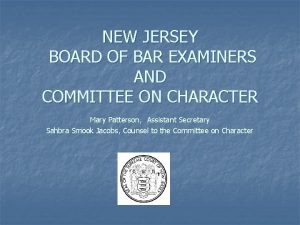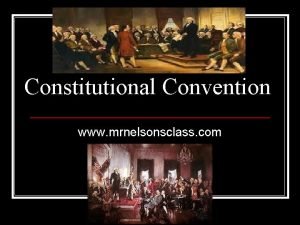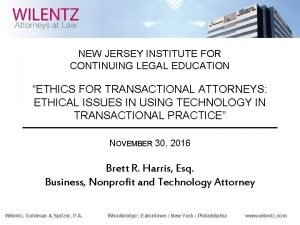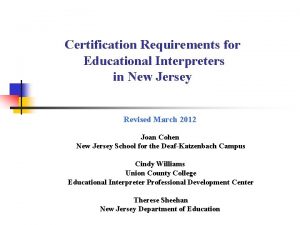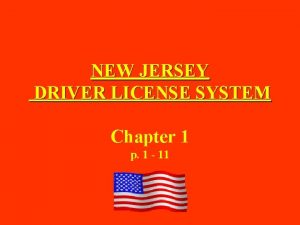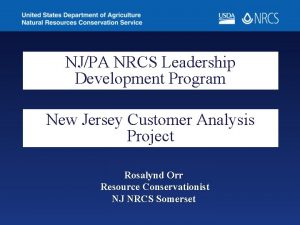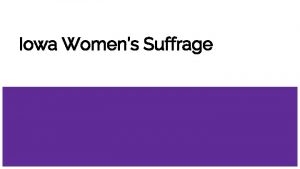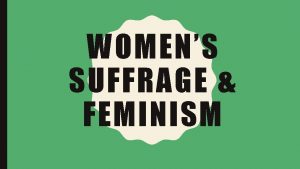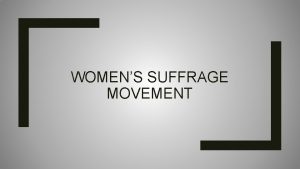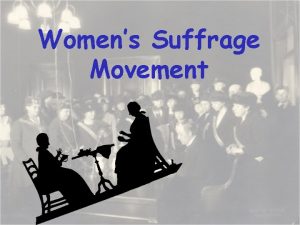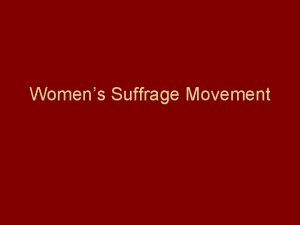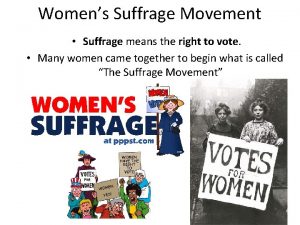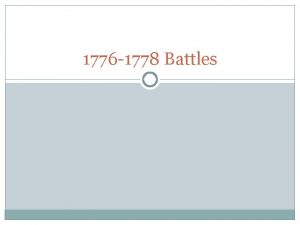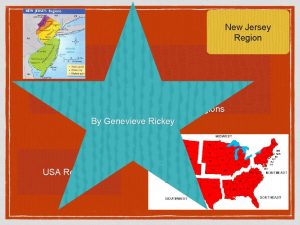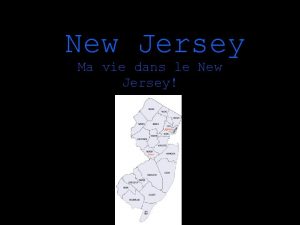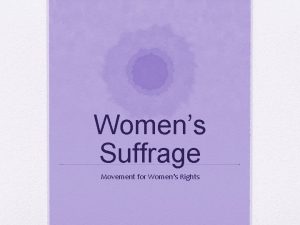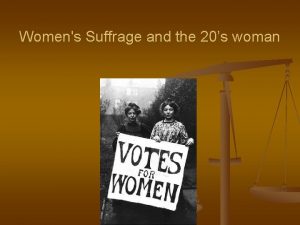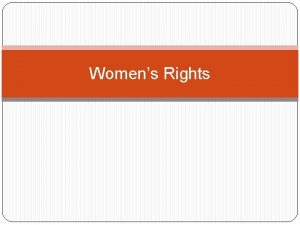Womens Suffrage Womens Suffrage in New Jersey 1776




















- Slides: 20

Women’s Suffrage

Women’s Suffrage in New Jersey, 1776– 1807 • New Jersey Constitution of 1776 allowed women with property to vote • Widows and unmarried women could vote • Ended by a legislative act in 1807 New Jersey and northeastern states, 1799

The “Cult of True Womanhood” • “True” women regarded as religious, pious, chaste, domestic, submissive • Domestic work seen as a divine calling • Married women lacked legal standing • Women’s suffrage did not have widespread appeal Illustration depicting many of the ideals of the “cult of true womanhood”

The 14 th and 15 th Amendments • 14 th Amendment: “equal protection” for all citizens, but mainly for “male citizens” • 15 th Amendment: allowed all male citizens to vote, regardless of race or former servitude; excluded women • Created a rift in the women's rights movement In this 1866 cartoon, the woman, “Columbia, ” represents America; the baby represents the newly passed 14 th Amendment

The NWSA and the AWSA • NWSA opposed the 15 th Amendment and wanted a constitutional amendment for universal suffrage; also divorce and other rights for women • AWSA favored the 15 th Amendment and called for a state-by-state campaign toward universal suffrage, focusing only on women’s suffrage • Rivals for 20 years

Constitutional Amendment and State Referendums • NWSA proposed a constitutional amendment every year beginning in 1869 • Unsuccessful attempt in Congress • Turned to state-by-state campaign • State referendums largely unsuccessful

Susan B. Anthony and Elizabeth Cady Stanton • Antislavery and temperance activists before the Civil War • Lifelong friends • Opposed the 15 th Amendment • Co-founded NWSA • Anthony organized merger between NWSA and AWSA and tried to reach out to moderates and conservatives in the movement • Stanton was more radical Stanton (seated) and Anthony

The Establishment of NAWSA • NWSA and AWSA merged to form NAWSA • Felt they were more likely to succeed at suffrage if they merged • Susan B. Anthony was first president; took a more realistic and moderate path • Stanton alienated because she remained more radical NAWSA officers, 1892

Questions for Discussion 1. Why was the 15 th Amendment so divisive for the women’s movement? 2. Why did Susan B. Anthony face criticism from some other women’s rights advocates? 3. If you had been a women’s rights advocate in the 19 th century, do you think you would have thought it was more promising to work toward a constitutional amendment or on a state-by-state passage of women’s suffrage laws? Why?

Women’s Suffrage in Wyoming • Women’s suffrage granted to Wyoming Territory residents over 21 in 1869 • Unclear why women’s suffrage succeeded first in Wyoming • Eastern women’s rights advocate sand journalists visited the territory • Retained women’s suffrage into statehood despite controversy Women voters in Wyoming

Women in the Progressive Era • Female leaders of progressive causes • Jane Addams • Increasingly active women’s clubs and organizations • Spread enthusiasm for women’s suffrage Jane Addams

Turn-of-the-Century Voices Against Women’s Suffrage • Voices against women’s suffrage grew louder • Helen Kendrick Johnson: democracy depended on separate roles • Lyman Abbott: women didn’t want to vote because it was men’s responsibility • Women were too physically frail; they would get tired just walking to the polling station

New Leaders in the Early 20 th Century Carrie Chapman Catt • Elizabeth Cady Stanton died in 1902; Susan B. Anthony died in 1906 • Carrie Chapman Catt • Alice Paul • Congressional Union for Woman Suffrage • National Woman’s Party Alice Paul

National American Woman Suffrage Association • Carrie Chapman Catt led NASAW and she believed in: 1. Careful state-by-state strategy 2. Support President Wilson even if he doesn’t outright support suffrage (because Democrats were a safer bet than Republicans) 3. Act ladylike! Don’t embarrass the movement

National Woman’s Party • Alice Paul led the NWP and believed in more aggressive strategies: • Focused on passing a Constitutional Amendment • Picked up un-ladylike strategies from British suffragists (e. g. , heckling politicians, picketing) • Refused to support President Wilson if he wouldn’t support woman suffrage • NWP members were arrested for picketing in front of the White House; they were put in jail, went on a hunger strike and were force-fed

President Woodrow Wilson and World War I • Inauguration created a rift in the women’s suffrage movement • Carrie Chapman Catt supported Wilson • Alice Paul protested against him • “Silent Sentinels” • Arrests and torture • Alice Paul’s hunger strike

The 19 th Amendment • Public support for women’s suffrage grew in response to prison abuses and Alice Paul’s hunger strike • 19 th Amendment failed in Congress the first time around • National Woman’s Party campaigned for pro-suffrage candidates • 19 th Amendment passed in 1919 and ratified in 1920 • Tennessee was the 36 th state to ratify and it passed by only 1 vote

Reaction to the 19 th Amendment • Many women were excited to vote, but some were afraid • 19 th Amendment emboldened many women • Flapper era

The Election of 1920 Warren G. Harding and his wife Florence • James M. Cox vs. Warren G. Harding • Both parties courted the female vote • Harding supported women’s suffrage in the Senate and was popular with women; landslide victory • No “radical” changes to politics or voting patterns after 19 th Amendment

Questions for Discussion 1. Why do you think many people at the turn of the century still opposed women’s suffrage? 2. Why did President Wilson change his mind about women’s suffrage and decide to support the 19 th Amendment? 3. Did women have a significant effect on the election of 1920? Why or why not?
 New york pennsylvania new jersey delaware
New york pennsylvania new jersey delaware Nj yokogawa
Nj yokogawa Social emotional learning standards nj
Social emotional learning standards nj Sea lice new jersey
Sea lice new jersey New jersey bar laptop program
New jersey bar laptop program Njscs
Njscs Eof ramapo
Eof ramapo New jersey plan vs virginia plan
New jersey plan vs virginia plan Flood dream ocean city new jersey 1971
Flood dream ocean city new jersey 1971 Viva new jersey vocabulary
Viva new jersey vocabulary Appalachian ridge
Appalachian ridge New jersey institute for continuing legal education
New jersey institute for continuing legal education New jersey interpreters
New jersey interpreters Jersey accent video
Jersey accent video Are motorized bicycles legal in new jersey
Are motorized bicycles legal in new jersey Chapter 1 the new jersey driver license system answers
Chapter 1 the new jersey driver license system answers Universal waste management in new jersey
Universal waste management in new jersey Virginia plan and new jersey plan venn diagram
Virginia plan and new jersey plan venn diagram Richard hackney
Richard hackney Hesaa njfams
Hesaa njfams Leadership development new jersey
Leadership development new jersey




